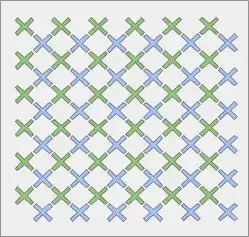Bristlecone's native operation is the CZ, not CNOTs. However, you can transform between the two with Hadamard gates so this is sort of a trivial difference.
Bristlecone can perform a CZ between any adjacent pair of qubits on a grid. You can see the grid by installing cirq and printing out the Bristlecone device:
$ pip install cirq
$ python
>>> import cirq
>>> print(cirq.google.Bristlecone)
(0, 5)────(0, 6)
│ │
│ │
(1, 4)───(1, 5)────(1, 6)────(1, 7)
│ │ │ │
│ │ │ │
(2, 3)───(2, 4)───(2, 5)────(2, 6)────(2, 7)───(2, 8)
│ │ │ │ │ │
│ │ │ │ │ │
(3, 2)───(3, 3)───(3, 4)───(3, 5)────(3, 6)────(3, 7)───(3, 8)───(3, 9)
│ │ │ │ │ │ │ │
│ │ │ │ │ │ │ │
(4, 1)───(4, 2)───(4, 3)───(4, 4)───(4, 5)────(4, 6)────(4, 7)───(4, 8)───(4, 9)───(4, 10)
│ │ │ │ │ │ │ │ │ │
│ │ │ │ │ │ │ │ │ │
(5, 0)───(5, 1)───(5, 2)───(5, 3)───(5, 4)───(5, 5)────(5, 6)────(5, 7)───(5, 8)───(5, 9)───(5, 10)───(5, 11)
│ │ │ │ │ │ │ │ │ │
│ │ │ │ │ │ │ │ │ │
(6, 1)───(6, 2)───(6, 3)───(6, 4)───(6, 5)────(6, 6)────(6, 7)───(6, 8)───(6, 9)───(6, 10)
│ │ │ │ │ │ │ │
│ │ │ │ │ │ │ │
(7, 2)───(7, 3)───(7, 4)───(7, 5)────(7, 6)────(7, 7)───(7, 8)───(7, 9)
│ │ │ │ │ │
│ │ │ │ │ │
(8, 3)───(8, 4)───(8, 5)────(8, 6)────(8, 7)───(8, 8)
│ │ │ │
│ │ │ │
(9, 4)───(9, 5)────(9, 6)────(9, 7)
│ │
│ │
(10, 5)───(10, 6)
Here is how you can get a set containing the allowed CZ operations:
qubits = cirq.google.Bristlecone.qubits
allowed = {cirq.CZ(a, b)
for a in qubits
for b in qubits
if a.is_adjacent(b)}
The set has 121 elements in it, and it's somewhat random whether you get CZ(x, y) or CZ(y, x) in the set, so I won't include a printout of the set here.
An additional constraint to keep in mind is that you cannot perform two CZs next to each other at the same time. Cirq takes this into account when creating circuits targeted at Bristlecone. For example:
import cirq
device = cirq.google.Bristlecone
a, b, c, d, e = device.col(6)[:5]
circuit = cirq.Circuit.from_ops(
cirq.CZ(a, b),
cirq.CZ(c, d),
cirq.CZ(a, b),
cirq.CZ(d, e),
device=device)
print(circuit)
# (0, 6): ───@───────@───
# │ │
# (1, 6): ───@───────@───
#
# (2, 6): ───────@───────
# │
# (3, 6): ───────@───@───
# │
# (4, 6): ───────────@───
The first two operations were staggered because they are adjacent CZs, but the second two weren't because they aren't.
